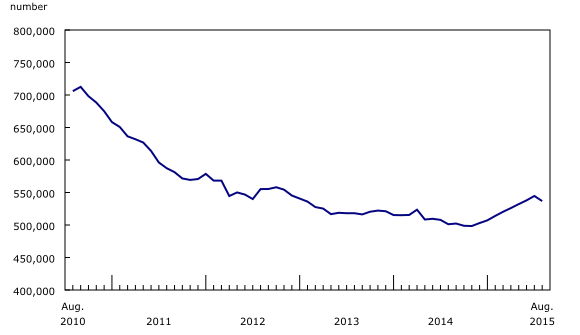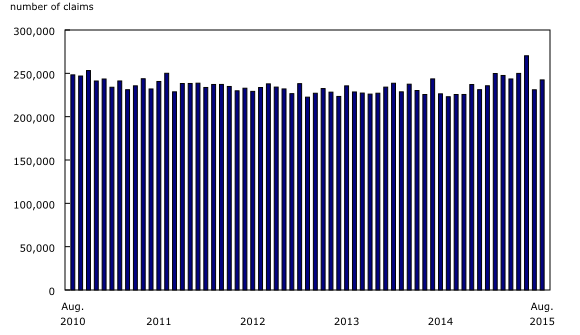Employment Insurance, August 2015
Archived Content
Information identified as archived is provided for reference, research or recordkeeping purposes. It is not subject to the Government of Canada Web Standards and has not been altered or updated since it was archived. Please "contact us" to request a format other than those available.
Released: 2015-10-22
In August, 7,900 fewer people received regular Employment Insurance (EI) benefits compared with July, down 1.4% to 536,800. On a year-over-year basis, the number of EI beneficiaries increased by 35,600 or 7.1%.
Most of the decrease in August came from Ontario, where the number of beneficiaries declined 3.9%. Smaller declines were recorded in Quebec (-1.9%) and Saskatchewan (-1.1%).
At the same time, the number of beneficiaries increased in Manitoba (+5.8%) and Prince Edward Island (+2.6%), while the remaining provinces reported little change.
The change in the number of regular EI beneficiaries reflects various situations, including people becoming beneficiaries, people going back to work and people no longer receiving regular benefits.
Provincial and sub-provincial overview
In Ontario, 149,100 people received EI benefits in August, down 3.9% from July. This was the largest decline in the number of beneficiaries for the province since April 2012. Of the 15 census metropolitan areas (CMAs) in Ontario, Oshawa recorded the largest decrease (-26.0%), offsetting most of the increase in July. Eight other metropolitan areas also posted declines, ranging from 2.5% in Brantford to 9.1% in Windsor. At the same time, the number of beneficiaries increased in Kingston (+2.5%), Barrie (+1.6%), Kitchener–Cambridge–Waterloo (+1.4%) and Hamilton (+1.0%), while there was little change in Guelph and Ottawa. Additionally, there were fewer people receiving benefits outside of the metropolitan areas (-2.6%).
The number of people receiving benefits in Quebec declined by 1.9% to 148,400 in August. Each of the six metropolitan areas in the province recorded declines, led by Saguenay (-3.7%) and the Québec CMA (-2.6%). The number of beneficiaries decreased by 2.5% in the census agglomerations (CA) and by 1.3% in the rest of the province.
In Saskatchewan, the number of beneficiaries edged down 1.1% to 14,000 in August, marking the first monthly decline since August 2014. Most of the monthly decrease came from the province's CAs (-2.9%) and Saskatoon (-1.6%), while Regina reported a 1.8% increase in beneficiaries.
In August, Manitoba saw the number of EI beneficiaries increase by 5.8% to 14,900. The largest increases for the month came from persons who last worked in occupations unique to processing, manufacturing and utilities (+12.2%), as well as in business finance and administrative occupations (+7.8%). Both the metropolitan area of Winnipeg (+10.5%) and the CAs (+4.2%) reported increases.
In Prince Edward Island, the number of beneficiaries rose by 2.6% to 7,400 in August, with increases in CAs (+2.1%) and areas outside of the CAs (+3.0%).
While there was little change in the number of EI beneficiaries in Nova Scotia, New Brunswick, Alberta, Newfoundland and Labrador and British Columbia, this was not the case in some areas within these provinces.
In Nova Scotia, the number of people receiving benefits declined in the CAs (-2.4%) in August, but was unchanged across the rest of the province.
In August, both CMAs in New Brunswick saw fewer people receiving EI benefits, down by 2.3% in Saint John and 1.5% in Moncton.
The number of EI beneficiaries rose 2.9% in Calgary in August, the 12th consecutive monthly increase. There was little change in the number of beneficiaries in Edmonton, while the number of people receiving benefits outside of metropolitan areas in Alberta declined by 2.6%.
In St. John's, Newfoundland and Labrador, the number of beneficiaries increased 1.8% in August. The number of people receiving EI benefits also increased in the CAs (+1.2%), but was little changed in the rest of the province.
Of the four CMAs in British Columbia, Kelowna saw the number of EI beneficiaries increase 2.2%, while Vancouver experienced a 1.1% gain. Victoria and Abbotsford–Mission were unchanged. The number of beneficiaries declined in the areas outside of CMAs and CAs (-1.5%).
Regular Employment Insurance beneficiaries by occupation
Compared with August 2014, there were more EI recipients among workers whose last job was in primary industry (+16.7%), natural and applied sciences (+16.5%), and who worked as trades, transport and equipment operators (+14.2%).
There was also an increase among people who had held management positions (+4.7%) before becoming beneficiaries, as well as among those who last worked in business, finance and administration (+4.0%), social science, education, government services and religion (+2.9%) and sales and service (+1.3%).
On the other hand, there were fewer beneficiaries among people who last worked in processing, manufacturing and utilities (-6.4%), and in art, culture, recreation and sport (-4.3%). The number of beneficiaries was unchanged for those persons who last worked in health.
Employment Insurance beneficiaries in major demographic groups
Compared with July, there were fewer EI beneficiaries among people aged 25 to 54, down 1.7% or 6,100. For this group, the decrease was greater among men (-2.1%) than among women (-1.0%).
The number of beneficiaries also declined among people aged 15 to 24, falling 1.6% or 900, with the majority of the decline among males (-1.9%).
On a year-over-year basis, the number of beneficiaries continued to increase for all age groups in August.
Employment Insurance claims
The number of EI claims increased by 4.9% to 242,400 in August. The number of claims provides an indication of the number of people who could become beneficiaries.
EI claims increased in seven provinces in August, led by Alberta (+14.8%), Ontario (+7.0%) and Newfoundland and Labrador (+4.5%). Claims also increased in British Columbia (+2.8%), Quebec (+2.6%), Saskatchewan (+2.5%) and New Brunswick (+1.3%).
At the same time, claims decreased in Prince Edward Island (-3.8%) and Nova Scotia (-1.3%). The number of claims was unchanged in Manitoba.
Note to readers
Regular Employment Insurance (EI) benefits are available to eligible individuals who lose their jobs and who are available for and able to work, but cannot find a job. To receive EI benefits, individuals must first submit a claim. The number of claims provides an indication of the number of people who could become beneficiaries.
There is always a certain proportion of unemployed people who do not qualify for benefits. Some unemployed people have not contributed to the program because they have not worked in the past 12 months or their employment is not insured. Other unemployed people have contributed to the program but do not meet the eligibility criteria, such as workers who left their job voluntarily or those who did not accumulate enough hours of work to receive benefits.
All data in this release are seasonally adjusted. For more information on seasonal adjustment, see Seasonally adjusted data – Frequently asked questions.
EI statistics are produced from administrative data sources provided by Service Canada and Employment and Social Development Canada. These statistics may, from time to time, be affected by changes to the Employment Insurance Act or administrative procedures.
The number of regular EI beneficiaries and the number of claims received for the current and previous month are subject to revision.
The number of beneficiaries is a measure of all people who received EI benefits from August 9 to 15. This period coincides with the reference week of the Labour Force Survey (LFS). However, initial and renewal claims data are for the entire month.
EI statistics indicate the number of people who received EI benefits, and should not be confused with LFS data, which provide information on the total number of unemployed people.
Geographical definitions
A census metropolitan area (CMA) or a census agglomeration (CA) is formed by one or more adjacent municipalities centred on a population centre. A CMA, also referred to as a 'metropolitan area' in this release, must have a total population of at least 100,000. A CA must have a population of at least 10,000. See Standard Geographical Classification 2011 – Definitions for more information.
Next release
EI data for September will be released on November 19.
Historical revision
With this release, the seasonally adjusted series for the EI statistics have been revised back to January 2012 to reflect the most recent seasonal factors.
Products
More information about the concepts and use of Employment Insurance statistics is now available online in the Guide to Employment Insurance Statistics (73-506-G), from the Browse by key resource module of our website under Publications.
Contact information
For more information, contact us (toll-free 1-800-263-1136; 514-283-8300; infostats@statcan.gc.ca).
To enquire about the concepts, methods or data quality of this release, contact Jeremy Weeks (613-951-1369; jeremy.weeks@canada.ca), Labour Statistics Division.
- Date modified:






